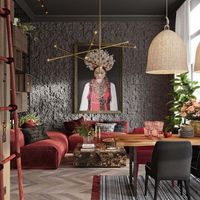## The Modern Office Meeting Room: A 3D Model for the Future of Collaboration
In today's dynamic business landscape, the office meeting room has evolved from a simple gathering space to a strategic hub for collaboration, innovation, and productivity. A well-designed meeting room fosters creativity, encourages effective communication, and enhances the overall work experience. This is where a 3D model comes in.
### The Power of 3D Modeling in Office Design
A 3D model is an indispensable tool for visualizing and designing any space, especially the meeting room. It offers several advantages:
1. Realistic Representation: 3D models provide a photorealistic representation of the meeting room, allowing stakeholders to visualize the space before it's built. This eliminates guesswork and potential design flaws.
2. Enhanced Collaboration: 3D models facilitate seamless collaboration between architects, designers, and clients. They can easily share, edit, and iterate on the design in real-time, ensuring everyone is on the same page.
3. Flexibility and Experimentation: 3D models offer a high level of flexibility for experimenting with different layouts, furniture arrangements, and decor options. This allows designers to find the optimal configuration for the room.
4. Cost Savings: 3D models help identify potential issues and design flaws early on, preventing costly rework during construction.
5. Sustainable Design: 3D models can incorporate sustainable design elements, such as energy-efficient lighting and materials, which contribute to a greener workplace.
### Designing the Modern Office Meeting Room: Key Elements
A modern office meeting room is characterized by its focus on functionality, aesthetics, and technology integration. Here are key design elements to consider:
1. Layout and Configuration:
* Open vs. Enclosed: Choose between an open plan for a collaborative atmosphere or an enclosed space for privacy and focus.
* Shape and Size: Consider the room's shape, size, and the number of participants it needs to accommodate.
* Furniture Arrangement: Select furniture that facilitates both individual and group work, with options for standing, sitting, and collaborative workspaces.
2. Technology Integration:
* Visual Display: Invest in a high-quality display system, such as a large screen TV or interactive whiteboard, for presentations and video conferencing.
* Audio System: Ensure clear audio for all participants, with microphones and speakers strategically placed throughout the room.
* Connectivity: Provide ample power outlets and high-speed internet connectivity for laptops, tablets, and other devices.
3. Lighting and Acoustics:
* Natural Light: Maximize natural light by using large windows and skylights, which can improve mood and focus.
* Artificial Lighting: Choose adjustable lighting to accommodate different activities and time of day.
* Acoustics: Control noise levels by using sound-absorbing materials on walls, ceilings, and furniture.
4. Materials and Finishes:
* Sustainable Materials: Opt for eco-friendly materials, such as recycled wood, bamboo, and natural fabrics.
* Color Palette: Select a color scheme that reflects the company's brand and creates a desired ambiance.
* Textural Elements: Incorporate different textures through furniture, wall coverings, and rugs for visual interest and comfort.
5. Ergonomics and Comfort:
* Comfortable Seating: Invest in ergonomic chairs that offer adjustable features for optimal comfort and posture.
* Standing Workstations: Provide standing desks or adjustable height tables to promote movement and reduce fatigue.
* Temperature Control: Ensure the room is well-ventilated and has adjustable temperature settings for year-round comfort.
### 3D Modeling: A Step-by-Step Guide
Using a 3D modeling software, designers can create a realistic representation of the meeting room, incorporating all the key elements mentioned above. Here's a step-by-step guide:
1. Planning and Conceptualization:
* Define the meeting room's purpose and target audience.
* Develop a preliminary concept sketch or mood board to visualize the desired aesthetic and layout.
2. 3D Modeling:
* Choose a 3D modeling software, such as SketchUp, Revit, or 3ds Max.
* Import floor plans and dimensions into the software.
* Model the walls, ceiling, and floor of the room.
3. Furniture and Decor:
* Select furniture models from online libraries or create custom models.
* Arrange furniture according to the desired layout.
* Add decor elements, such as plants, artwork, and rugs.
4. Lighting and Materials:
* Apply lighting to create realistic shadows and ambiance.
* Choose and assign materials to different surfaces for accurate visual representation.
5. Rendering and Visualization:
* Render the 3D model to create high-quality images or animations.
* Experiment with different camera angles and lighting to showcase the space effectively.
6. Collaboration and Feedback:
* Share the 3D model with stakeholders for feedback and revisions.
* Use the feedback to refine the design and address any concerns.
### The Benefits of a Modern 3D Modeled Meeting Room
Investing in a modern, 3D modeled meeting room offers numerous benefits for businesses and organizations.
* Enhanced Collaboration: A well-designed meeting room fosters better communication, creativity, and teamwork.
* Increased Productivity: The right environment can boost employee morale, focus, and productivity.
* Improved Brand Image: A modern and stylish meeting room reflects a company's values and commitment to innovation.
* Enhanced Client Experience: A welcoming and functional meeting room creates a positive impression on clients and partners.
* Sustainable Practices: The use of sustainable materials and technologies contributes to a greener and more environmentally friendly workspace.
### Conclusion
The modern office meeting room is much more than just a place to hold meetings. It's a strategic space that plays a crucial role in driving innovation, fostering collaboration, and ultimately, achieving organizational goals. A 3D model is an essential tool for designing and visualizing these spaces, ensuring that they are functional, aesthetically pleasing, and technologically advanced. By investing in a well-designed meeting room, businesses can unlock the full potential of their workforce and stay ahead of the curve in a rapidly evolving world.





















Comment (0)